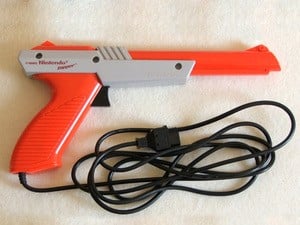
Light guns were around in the 1930’s beginning with Seeburg’s Ray-O-Light arcade shooter all the way back in 1936. The game involved a moving duck which must be shot in order to achieve a point. Arguably this early arcade title was inspiration for Nintendo’s very own Duck Hunt.
The first commercial light gun to hit a home video game console came in the form of Shooting Gallery on the Magnavox Odyssey. The rifle that was included as the light gun was only playable on a Magnavox TV set and as a result of this sales were considerably dented – with only 20,000 copies of the game being sold.
Given it’s limited success this release is worth mentioning seeing as many believe the NES Zapper to be the first home console light gun released – this in fact is far from the truth, however you might be correct in stating that once again it was Nintendo that mastered the peripheral and set the standard for light guns to follow.
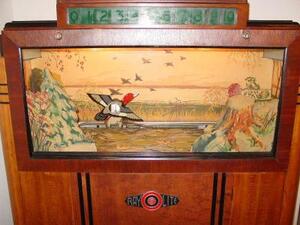
NES Zapper
The NES Zapper was released as part of the Nintendo Entertainment System package in 1985 (which included a console, the Zapper, Duck Hunt, Super Mario Bros. and a controller) and has since become arguably the most iconic light gun peripheral in video gaming history.
Coloured bright orange in the US and UK the traditional revolver look of the Famicon version was given a more “ray-gun” feel for the Western world. The Zapper was coloured orange due to a federal law that was passed, concerned with the deception of using the Zapper gun as a real gun.
Some of the more popular compatible games were:
Duck Hunt
Probably the most recognisable game for the Zapper – this game required you to simply shoot a number of ducks as they flew around the screen. The game was simple but addictive and responded excellently to the NES Zapper.
Hogan’s Alley
An FBI training game whereby cardboard cutouts of bad guys and good guys appear and you are left with taking down the bad guys. This was arguably (for me) a lot better than Duck Hunt but sadly is overlooked (like most NES Zapper games) due to the iconic status of Duck Hunt.
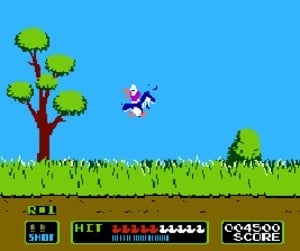
Wild Gunman
This was the first NES game to use voice synthesis and was based on a simple concept of your reactions. You’d have to shoot the figure on screen before they shot you. Simple but difficult at times – and the pressure really told on later levels.
Super Scope (Super Nintendo)
One of the least successful stories in Nintendo history (aside from the Power Glove and Virtual Boy) was the Super Scope. The bulky (bazooka-like) device was panned for being cumbersome, over the top and painful. Not only that but the Super Scope drank 6 AA batteries juice in less than four hours making prolonged gaming sessions not only tiring, but expensive too.
Due to the lack of success of the Super Scope there was also a lack of software support – with few games being compatible and those of which were not being particularly enjoyable.
Packaged with the console was Super Scope 6 – a cartridge which allowed you to calibrate the hardware and also offering six games – including Tetris and Columns type clones, a whack a mole game, and various other generic “shoot missile” type games.

Other games compatible for the Super Scope:
Yoshi’s Safari
An on-the-rails shooter whereby you ride on the back of Yoshi and fire at various Koopa’s, Goomba’s and other such familiar enemies from the “Mario Kingdom”. The game was widely overlooked but marked a milestone in that it was the first game to refer to Princess Toadstool as Princess Peach – setting up the name change for when Mario 64 would finally appear and change the world.
Operation Thunderbolt
The sequel to popular arcade game Operation Wolf; Operation Thunderbolt saw release on a number of different platforms and was compatible with the Nintendo Mouse or the Super Scope. Aiming of the scope put you in the position to take out a number of foreign “baddies” and capture a number of bases.
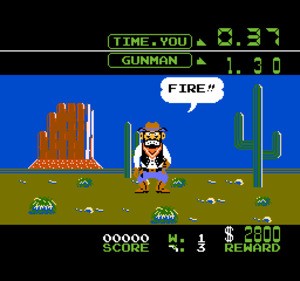
Wii Zapper
With both the N64 and GameCube missing out on any light gun action the announcement of the Wii Remote saw many arcade shooter enthusiasts rejoice. While operating differently to the traditional light gun setup (the Wii has a sensor bar to detect relation to the screen) the controller would allow for the precise aiming ever present in arcade shooters.
However, although the Wii has been out nearly a year now we have seen few true arcade shoot ‘em ups. However this is all set to change with the release of the Wii Zapper.
Acting as a shell for the input of both the Wii Remote and Nunchuk the hardware extends the B button trigger on the back of the Wii Remote and allows for a more “arcade” shooting experience to be enjoyed.
The hardware will come packaged with Link’s Crossbow Training, a set of minigames based upon the Twilight Princess engine.
Other games compatible with the Wii Zapper are:
Resident Evil: The Umbrella Chronicles
Filling in the gaps in the story from the previous six Resident Evil games, Umbrella Chronicles is an on the rails shooter taking you through various locations from the Resident Evil series and pitting you against hordes of Zombies. You will be able to pick your routes through the levels, allowing you to uncover different secrets and plot twists along the way.
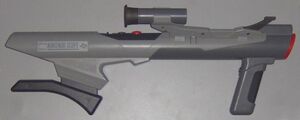
Ghost Squad
SEGA’s arcade favourite will be converting its way to the Wii with full compatibility of the Wii Zapper. The full arcade game will be included along with a new four-player mode and the inclusion of high score leader boards via Nintendo Wi-Fi Connection.
Arcade Shooters We’d Like To Be Announced:
- Police 24/7
- Point Blank
- Time Crisis
- Operation Wolf (on the Virtual Console)
- Virtua Cop
- Duck Hunt 2 (please Nintendo?)
The Wii Zapper will launch in North America on November 19th in North America and December 7th in the UK. The hardware will be priced at $19.99 and £19.99 respectively.
Expect full reports on the new hardware and it’s compatible games as the releases get nearer.
Comments 2
I've never heard of the Super Scope, I'm glad I didn't it was huge! The original Zapper was great though, I used to carry it around with me outside of the house to look "cool", I'm pretty sure that I achieved the look...
It was a great gun though, I remember the noise that the trigger made when it finally clicked down all the way.
All there have been better light guns, the Zapper will forever be in my heart. Now I'm going to check ebay
Nice feature, great idea too
The Super Scope was a massive waste of time, I guess Nintendo thought it would look cool to have a bazooka size firearm but in reality it was cumbersome and sucked up batteries like there was no tomorrow. I will admit to wanting one though! I never got one, but played on a friends - that was enough to put me off.
Show Comments
Leave A Comment
Hold on there, you need to login to post a comment...